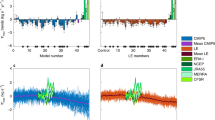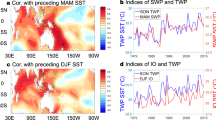Abstract
A critical aspect of human-induced climate change is how it will affect precipitation around the world. Broadly speaking, warming increases atmospheric moisture holding capacity, intensifies moisture transports and makes sub-tropical dry regions drier and tropical and mid-to-high-latitude wet regions wetter1,2. Extra-tropical precipitation patterns vary strongly with longitude, however, owing to the control exerted by the storm tracks and quasi-stationary highs and lows or stationary waves. Regional precipitation change will, therefore, also depend on how these aspects of the circulation respond. Current climate models robustly predict a change in the Northern Hemisphere (NH) winter stationary wave field that brings wetting southerlies to the west coast of North America, and drying northerlies to interior southwest North America and the eastern Mediterranean3,4,5. Here we show that this change in the meridional wind field is caused by strengthened zonal mean westerlies in the sub-tropical upper troposphere, which alters the character of intermediate-scale stationary waves. Thus, a robust and easily understood model response to global warming is the prime cause of these regional wind changes. However, the majority of models probably overestimate the magnitude of this response because of biases in their climatological representation of the relevant waves, suggesting that winter season wetting of the North American west coast will be notably less than projected by the multi-model mean.
This is a preview of subscription content, access via your institution
Access options
Subscribe to this journal
Receive 12 print issues and online access
$209.00 per year
only $17.42 per issue
Buy this article
- Purchase on Springer Link
- Instant access to full article PDF
Prices may be subject to local taxes which are calculated during checkout





Similar content being viewed by others
References
Held, I. M. & Soden, B. J. Robust responses of the hydrological cycle to global warming. J. Clim. 19, 5686–5699 (2006).
Seager, R., Naik, N. & Vecchi, G. A. Thermodynamic and dynamic mechanisms for large-scale changes in the hydrological cycle in response to global warming. J. Clim. 23, 4651–4668 (2010).
Neelin, J. D., Langenbrunner, B., Meyerson, J. E., Hall, A. & Berg, N. California winter precipitation change under global warming in the Coupled Model Intercomparison Project phase 5 ensemble. J. Clim. 26, 6238–6256 (2013).
Seager, R. et al. Causes of increasing aridification of the Mediterranean region in response to rising greenhouse gases. J. Clim. 27, 4655–4676 (2014).
Seager, R. et al. Dynamical and thermodynamical causes of large-scale changes in the hydrological cycle over North America in response to global warming. J. Clim. 27, 7921–7948 (2014).
Held, I. M., Ting, M. & Wang, H. Northern winter stationary waves: Theory and modeling. J. Clim. 15, 2125–2144 (2002).
Brandefelt, J. & Körnich, H. Northern Hemisphere stationary waves in future climate projections. J. Clim. 21, 6341–6353 (2008).
Haarsma, R. J. & Selten, F. Anthropogenic changes in the Walker circulation and their impact on the extra-tropical planetary wave structure in the Northern Hemisphere. Clim. Dynam. 39, 1781–1799 (2012).
Simpson, I. R., Shaw, T. A. & Seager, R. A diagnosis of the seasonally and longitudinally varying midlatitude circulation response to global warming. J. Atmos. Sci. 71, 2489–2515 (2014).
Stephenson, D. B. & Held, I. M. GCM response of northern winter stationary waves and storm tracks to increasing amounts of carbon dioxide. J. Clim. 6, 1859–1870 (1993).
Selten, F. M., Branstator, G. W., Dijkstra, H. A. & Kliphuis, M. Tropical origins for recent and future Northern Hemisphere climate change. Geophys. Res. Lett. 31, L21205 (2004).
Branstator, G. & Selten, F. “Modes of Variability” and climate change. J. Clim. 22, 2639–2658 (2009).
Joseph, R., Ting, M. & Kushner, P. J. The global stationary wave response to climate change in a coupled GCM. J. Clim. 17, 540–556 (2004).
Wang, L. & Kushner, P. J. Diagnosing the stratosphere-troposphere stationary wave response to climate change in a general circulation model. J. Geophys. Res. 116, D16113 (2011).
Branstator, G. Circumglobal teleconnections, the jet stream waveguide and the North Atlantic Oscillation. J. Clim. 15, 1893–1910 (2002).
Manabe, S. & Wetherald, R. T. The effects of doubling the CO2 concentration on the climate of a general circulation models. J. Atmos. Sci. 32, 3–15 (1975).
Wu, Y., Seager, R., Ting, M., Naik, N. & Shaw, T. A. Atmospheric circulation response to an instantaneous doubling of Carbon Dioxide. Part 1: Model experiments and transient thermal response in the troposphere. J. Clim. 25, 2862–2879 (2011).
Hoskins, B. J. & Karoly, D. J. The steady linear response of a spherical atmosphere to thermal and orographic forcing. J. Atmos. Sci. 38, 1179–1196 (1981).
Held, I. M. in Large-Scale Dynamical Processes in the Atmosphere (eds Hoskins, B. J. & Pearce, R. P.) 127–128 (Academic Press, 1983).
Dee, D. P. et al. The ERA-Interim reanalysis: Configuration and performance of the data assimilation system. Q. J. R. Meteorol. Soc. 137, 553–597 (2011).
Ma, J. & Xie, S.-P. Regional patterns of sea surface temperature change: A source of uncertainty in future projections of precipitation and atmospheric circulation. J. Clim. 26, 2482–2501 (2013).
He, J., Soden, B. J. & Kirtman, B. The robustness of the atmospheric circulation and precipitation response to future anthropogenic surface warming. Geophys. Res. Lett. 41, 2614–2622 (2014).
Thorne, P. W., Lanzante, J. R., Peterson, T. C., Seidel, D. J. & Shine, K. P. Tropospheric temperature trends: History of an ongoing controversy. WIREs Clim. Change 2, 66–88 (2011).
Deser, C., Phillips, A., Bourdette, V. & Teng, H. Uncertainty in climate change projections: The role of internal variability. Clim. Dynam. 38, 527–546 (2012).
Lu, J., Vecchi, G. A. & Reichler, T. Expansion of the Hadley cell under global warming. Geophys. Res. Lett. 34, L06805 (2007).
Scheff, J. & Frierson, D. M. W. Robust future precipitation declines in CMIP5 largely reflect the poleward expansion of model subtropical dry zones. Geophys. Res. Lett. 38, L18704 (2012).
Devore, J. L. Probability and Statistics for Engineering and the Sciences 5th edn, 535–536 (Brooks/Cole, 1999).
Ting, M. & Yu, L. Steady response to tropical heating in wavy linear and nonlinear baroclinic models. J. Atmos. Sci. 55, 3565–3582 (1998).
Nigam, S., Held, I. M. & Lyons, S. W. Linear simulation of the stationary eddies in a general circulation model. Part 1: The no-mountain model. J. Atmos. Sci. 43, 2944–2961 (1986).
Acknowledgements
We are grateful to H. Liu and N. Henderson for maintaining the LDEO CMIP-5 archive that houses most of the data used in this study. This work was funded by NSF awards AGS-1317469 and AGS 1243204. TAS acknowledges funding from NSF CAREER award AGS-1538944 and the David and Lucile Packard Foundation. We acknowledge the World Climate Research Programme’s Working Group on Coupled Modelling, which is responsible for CMIP, and we thank the climate modelling groups listed in Supplementary Table 1 for producing and making available their model output. For CMIP the US Department of Energy’s Program for Climate Model Diagnosis and Intercomparison provides coordinating support and led development of software infrastructure in partnership with the Global Organization for Earth System Science Portals.
Author information
Authors and Affiliations
Contributions
All authors conceived of the study. I.R.S. conducted the analysis and modelling and all authors contributed to the interpretation of results. M.T. provided the stationary wave model code and advice on its set-up and I.R.S. wrote the manuscript with input from all authors.
Corresponding author
Ethics declarations
Competing interests
The authors declare no competing financial interests.
Supplementary information
Rights and permissions
About this article
Cite this article
Simpson, I., Seager, R., Ting, M. et al. Causes of change in Northern Hemisphere winter meridional winds and regional hydroclimate. Nature Clim Change 6, 65–70 (2016). https://doi.org/10.1038/nclimate2783
Received:
Accepted:
Published:
Issue Date:
DOI: https://doi.org/10.1038/nclimate2783
This article is cited by
-
Projected increase in summer heat-dome-like stationary waves over Northwestern North America
npj Climate and Atmospheric Science (2023)
-
Decadal changes in the intraseasonal variability of intensity and location of East Asian polar-front jet around 2000 and associated mechanisms
Climate Dynamics (2023)
-
Spatiotemporal Variability in Extreme Temperature Events in an Arid-Semiarid Region of China and Their Teleconnections with Large-Scale Atmospheric Circulation
Journal of Earth Science (2023)
-
Prediction and projection of heatwaves
Nature Reviews Earth & Environment (2022)
-
Precipitation trends determine future occurrences of compound hot–dry events
Nature Climate Change (2022)



